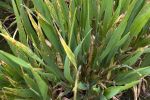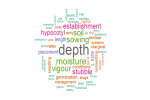In the mid-1990s to early 2000s, researchers from CSIRO and the Queensland Department of Primary Industries (DPI) were researching farming system dynamics in a bid to make the most of the dynamic nature of cropping in the north. Plant-available water triggers determining cropping decisions were investigated.
Over time, the GRDC projects led by DPI’s Dr David Lawrence and CSIRO’s Dr Lindsay Bell came together. Since then, researchers from both organisations have been involved in farming systems research. The latest iteration of the project celebrates 10 years in 2025.
What is farming systems research?
Farming systems research is a holistic approach where the interactions between various farming system elements are researched beyond seasonal production.
Historically, most farming systems experiments have examined either singular modifications or predetermined changes, such as crop rotations. This means important interactions can be missed or the research is too inflexible to represent a farming system’s dynamic nature.
What is a lever?
Farming systems research often refers to ‘levers’. Essentially, these levers mirror the complex set of decisions that growers make.
For example, in the north, there is a broad range of potential crops, each with different sowing windows across both summer and winter. With that comes different soil water requirements, plus the capacity to store soil water during fallows for subsequent crops.
However, CSIRO’s Dr Lindsay Bell says there are four common levers for maximising farming system performance:
- crop intensity or frequency;
- crop diversity;
- nutrient supply strategy; and
- the capacity to maintain long-term soil quality through only grain crops or the use of pasture leys or cover crops.
“We wanted to explore what levers could be pulled to have the most benefit – as in crop sowing frequency, crop sequencing and nutrition.”
What systems were tested?
Across this project, experiments have occurred at seven locations: a core experimental site comparing 38 farming systems at Pampas near Toowoomba, and a further six regional sites from Central Queensland to central NSW. At these regional sites, the following systems were tested.
Baseline
This is a conservative zero-till system targeting one crop a year.
Crops are limited to wheat, barley, chickpeas and sorghum, with nutrient application rates on cereals targeting the median (50th percentile) seasonal yield potential.
Higher crop intensity
This focused on increasing the cropping intensity to 1.5 crops a year when water allows. Crops include wheat, chickpeas, sorghum, mungbeans and forage crops or legumes, with nitrogen rates on cereals targeting the median (50th percentile) seasonal yield potential.
Higher legume
In this system, the frequency of pulses in the baseline system is increased to one pulse crop every two years. This is to assess the impact of more legumes on profitability, soil fertility, disease and weeds. Nitrogen rates on cereals target the median (50th percentile) seasonal yield potential.
Higher crop diversity
This forces a ‘double break’ between crops, reducing risk of disease (crown rot and root lesion nematodes) build up and herbicide resistance. A greater suite of crops is grown to achieve this. Nitrogen rates on cereals and oilseeds target the median (50th percentile) seasonal yield potential.
Higher nutrient supply
In this system, the same crops are grown as the baseline system each season with nitrogen and phosphorus rates increased to target the 90th percentile yield potential based on soil moisture in an environment of variable climate.
Higher soil fertility
This system is the same as the higher nutrient supply system, with an additional 60 tonnes a hectare of manure (10t/ha organic carbon) applied to change the starting soil fertility level.
This system is designed to see if higher initial soil fertility can be maintained with greater nutrient inputs – 90th percentile.
Integrated weed management
This minimum tillage system is focused on one crop a year but employs a wide range of practices to reduce the reliance on traditional knockdown herbicides – that is, narrower rows, higher populations and more residual herbicides. Crops include wheat, chickpeas, sorghum and mungbeans, with nitrogen rates on cereals targeting the median (50th percentile) seasonal yield potential.

























































